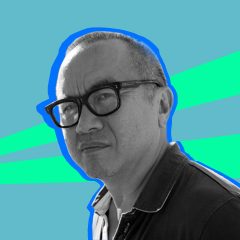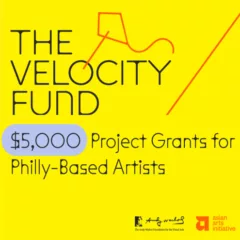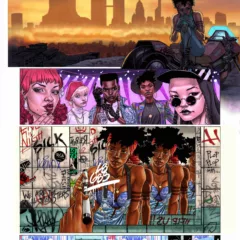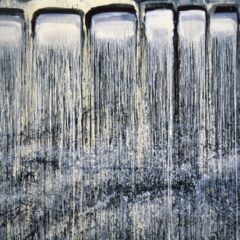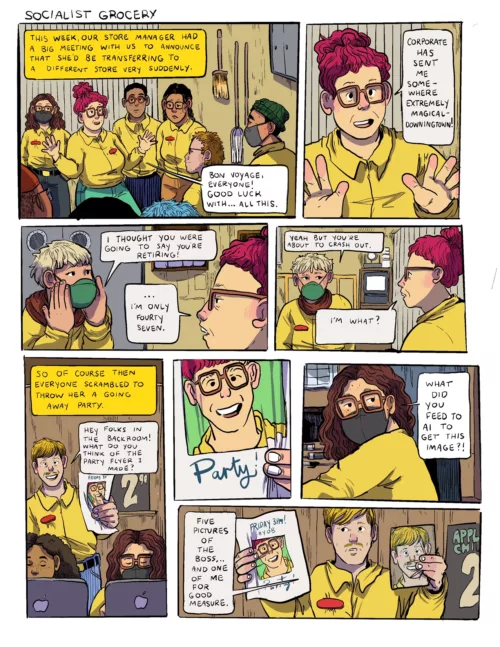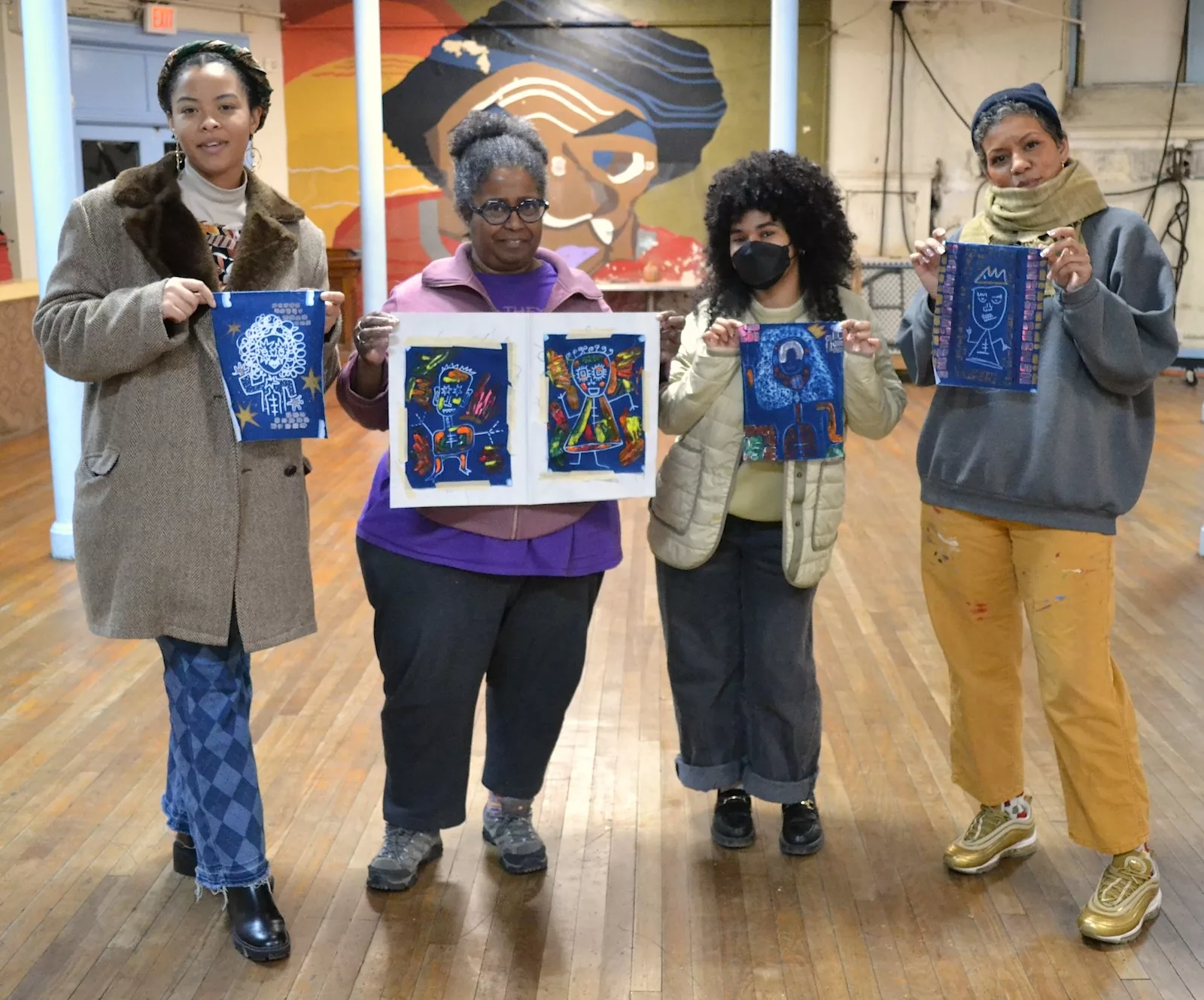
I talked with two 2023 Velocity Fund grantees this summer, Yvonne Lung of “Let’s Talk about Chinatown,” and Joy O. Ude of “Threading the Needle.” Both projects are reaching the end of their funding cycle this August, and I wanted to catch up with them and hear how the projects are going. Both projects involve community work, which is a hallmark of the Velocity Fund itself, created to foster artist projects within a community. And both come from the personal beliefs of the artists – who are both educators – that teaching and education are agents of change.
In this post we have my conversation with Joy O. Ude. It was an exhilarating conversation, filled with the artist’s high energy and love of making and of community. In her project, she is teaching the teachers, in workshops that focused on fiber techniques. Showing flexibility, she changed the workshops once she met the students and saw how their various levels of experience with materials and techniques meant a one-size-fits-all approach would be less useful to them than one that was individually responsive to their needs. Read full description of the project here. I spoke with Joy O. Ude July 24, 2024, on Zoom.
Roberta: You’re from Texas. How long have you been in Philly and how did you arrive here?
Joy O. Ude: Well, it’s a combination of pre-covid and post-covid. So pre-covid, I actually arrived here in January of 2015. I got into the (post-grad apprentice) program at the Fabric Workshop and Museum. But as that was finishing up, they knew that some of their studio staff were going to be leaving and they asked me to apply for one of the positions, full-time studio staff. So I applied and they hired me because I had both a screen printing and sewing background from undergrad and grad school. I hadn’t done large scale printing, which is what attracted me to the program. So it was the Fabric Workshop that brought me to Philadelphia in 2015. And I was here until about July, 2020.
During COVID, I thought should I take some time to be closer to family in Texas, at least for a couple of years. And so I started the certification process to teach in public schools while I was still in Philly. I moved to Texas in July and was there for two years teaching as an art teacher, then came back to Philly in the summer of 2022.
So, five years on the front end. And then about another two years on the back end, so about seven years total.
Roberta: Wow. That makes you pretty much a native, haha.
Joy O. Ude: Yeah. I didn’t even want to leave. And thinking about going back to Texas, I love that so much of my family is there, but politics wise, I’m just no, no, no.
The Importance of Teaching
I was thinking about how teaching is important to me. Like it’s my love, I love doing it. It’s equal, to me, not secondary, to the creative process. And being able to teach and teach teachers. That’s why I wrote the grant the way I did. It is so important.
And so I didn’t want to lose that in any way, but at the same time, I know I couldn’t stay in Texas long term.
Roberta: I love your focus on teaching and teaching the teachers and teaching being co-equal with making. Where did that come from? Have you been a maker all your life? Or a teacher all your life? Do you have siblings that you were teaching?
Joy O. Ude: Yes, exactly. And my mom reminded me earlier this year, ’cause I said something offhandedly to her about teaching. It might have been the excitement of getting the grant, but she’s like, ‘You know you’ve been teaching since you were little.’
And I was like, ‘I didn’t (know that).’ She’s like, ‘Yeah, you used to make your younger brother sit down in a chair and you would show him how to do stuff.’ And I don’t remember doing that, but you know, she was a teacher when we were younger and she also worked in daycares and she was like, you’ve been teaching since you were little.
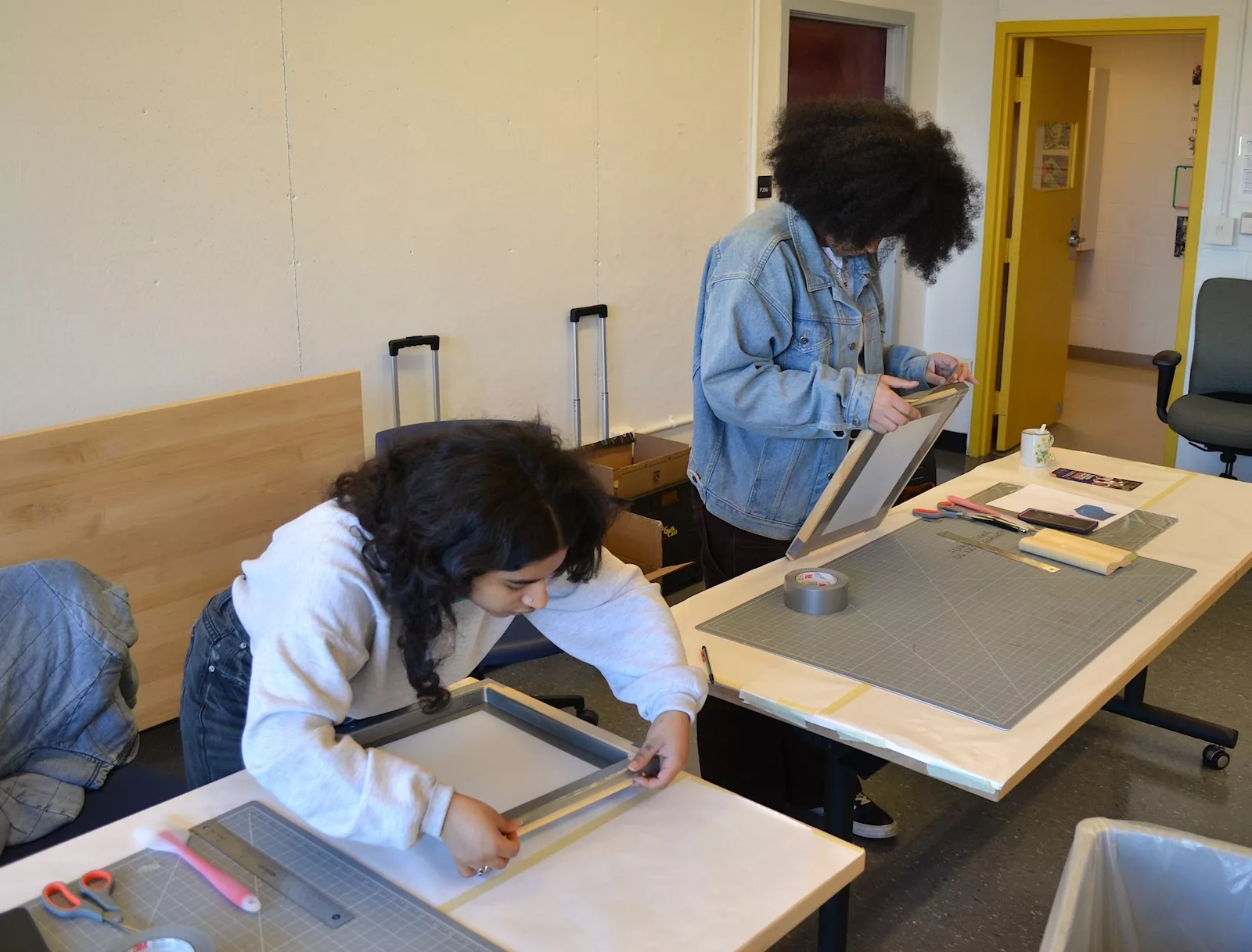
Love of Fibers and Making
I’ve been making since I can remember, in little ways, but really got into fibers, which I didn’t know the name for it at the time. I just knew I loved to embroider and I loved to crochet and macrame. I stole my mom’s Reader’s Digest book that had all the needlepoint things. I’ve been doing that since I was eight.
So very early on, I love working with my hands. I liked opening things and figuring out how they work. My dad’s a computer scientist and mathematician. And sometimes he would open his computers that he had and I would just sit there and watch him, like messing with things. I, at one point in high school, fixed a CD player. It was by accident. I don’t really know what I did, but I opened it. And messed with some stuff and put it back together. It ended up working.
Books first, then YouTube, if it’s good
And I taught myself how to shuttle tatting (lace making). I learned how to make lace from a book. And so from a book – not from YouTube. No, I always say this all the time, even to my students now in the elementary school. I know that those resources (YouTube) are there, but my natural inclination – growing up in libraries and loving books so much – is to find a version of a book or a printed copy of something,
And yes, of course, like especially in teaching, it’s great that there’s so many resource videos and I share those first and foremost with my students. But I try to pair it also with a really great book.
Videos help because it does help to see, especially overhead, someone’s hands, like how they’re working. But those are always my first preference if I can find them, if I can find good ones.
‘Threading the Needle’
Roberta: Let’s talk about your project now. Where are you in the process?
Joy O. Ude: I’m trying to create an online resource library for the teachers based on both the projects that we worked on and some of the sample lesson plans that I created.
I’ve never taught a workshop series that was just me and not through an institution or organization. I had in mind that we would work on making just small samples of each technique, so, embroidery, cyanotype weaving. And then possibly at the end we would have time to go over the example lesson that I drafted, and tied to an artist, (e.g. Alma Woodsey Thomas).
Flexibility and the workshops
Roberta: You said that you initially proposed the workshops for K-12 teachers but that you opened that up.
Joy O. Ude: I opened it up from just being K through 12 teachers to being community teachers because it felt like it was too limiting. And, we got a nice mix of community instructors and teachers that had had classroom experience all the way up to college. So they got an opportunity to talk about their experiences, to ask each other questions, to ask each other advice, to feel like they could safely speak about their experience in a community of people that looked like them and had some similar experiences, which we all participated in. I felt like it was more important to have that time. All of us have written a lesson plan, and let’s focus on the demonstration and exploration of using the material and also in having the conversation so that it’s like a creative outlet. It’s almost like, you know, mini art therapy sessions.
It shifted from the structure I thought it would have, but it ended up being really rewarding and really enriching, as an experience for all of us.
Roberta: So you also shifted the structure midstream based on your experience with the teachers?
Joy O. Ude: Right after the first class, and this is something that’s important to me, teaching any sort of class, I don’t want there to be a sense of urgency that would discount what you’re enjoying or what you’re really feeling is helpful as part of the learning experience. It’s okay if we don’t get to some things as long as you feel like the meat of what we did really did have an impact and really did help you consider the way that you’re working and what you might wanna do next.
Some people are like, I have a specific project in mind, I wanna focus on that. In that case, I make my way around the room, I navigate. It’s important that everyone understand the basics of what we’re talking about, but then if some people are ready to take off and really just get weird with whatever they wanna do, or really just focus in on one thing, I want them to feel like they’re getting that. And then I can still assist the people that are either stuck on technique or just really want some more practice. And that’s what’s important to them.
The Digital Archive
Roberta: Talk about the online resources library for teachers. Will this be available to everyone on the web?
Joy O. Ude: Yeah, that’s the hope. I’m figuring out what the best format is for that. I don’t know what it’s gonna be. Is it gonna be a website? Is it gonna be an archive? I’m trying to think of what would be most accessible. But yes. Whether or not you took the workshops because it ended up being sort of a smaller group over the course of the series. I don’t think it should be restricted to only the people that attended in person.
I think that it’s something that could be really helpful to any sort of classroom or community teacher. And that really is the whole goal. “Threading the Needle.” is meant to be a platform for accessibility specifically and especially for bipoc educators, but I don’t think that should limit it from people that just are interested or just don’t know how to start, or how to get started in teaching embroidery or coiling or something like that.
Contact Joy O. Ude through Joy of Textiles. Or email her at threadtheneedlephl@gmail.com
threadtheneedlephl on Instagram
Read Roberta’s 2024 interview with Velocity Fund awardee, Yvonne Lung.
More About the Velocity Fund
The Velocity Fund offers twelve Philadelphia-based artists and collectives $5000 to develop and present new projects — particularly those that are experimental in genre, collaborative in practice, grounded in their communities, and thoughtful in their impact. Independent artists, collaborative groups, and non-incorporated collectives are welcome to apply. Applications will open this Fall. Here’s a full list of the 2023 awardees. Apply here.
The Velocity Fund intends to directly support artists and arts-based cultural organizers who conduct their practice outside the studio, and who present them outside traditional art spaces. A Regional Regranting Program of the Andy Warhol Foundation for the Visual Arts, Velocity has funded multidisciplinary and varied work that use visual arts — including (but never limited to) printmaking, performance, video, puppetry, sculpture, and curation — to expand, archive, learn with, and lift up their publics.
More 2023 Grantee Updates
This spring, Our Fishing Log had a blast doing a workshop series all about porgy with middle and high schoolers in Fishadelphia’s youth program at Mastery Charter Thomas Campus in South Philadelphia. Together we read an essay by environmental historian Jayson Porter titled “Fish Hacks,” made a collective zine, and created gyotaku-style fish prints, which will be on display at the Parkway Central Library from September 14, 2024 – January 17, 2025!
something soft is a multimodal performance ritual exploring modalities of softness through diverse ideas of technology. The work is inspired, which is to say given breath, by black, neurodivergent, queer, trans and non-binary folk. Through material studies, somatic movement, sound and altars we collectively explore our softest bodies. After presenting at the Painted Bride (March 23 – April 28, 2024), we hope to continue offering iterations of this work as an ode to being, togetherness and mundanity as resistance.


